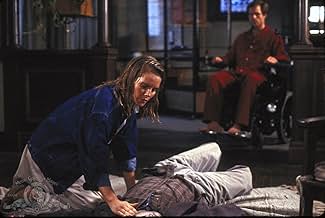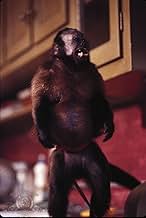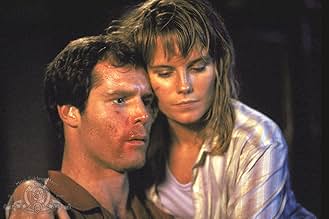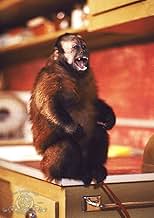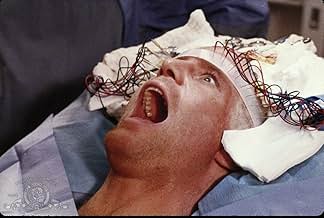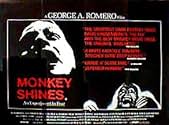A paralyzed man's friend gives him a smart monkey.A paralyzed man's friend gives him a smart monkey.A paralyzed man's friend gives him a smart monkey.
- Director
- Writers
- Stars
- Awards
- 7 wins & 2 nominations total
- Director
- Writers
- All cast & crew
- Production, box office & more at IMDbPro
Featured reviews
It seems that every once and a while, a neat little horror film comes along that eschews genre conventions and is able to tap into a new vein to provide its scares. Writer-director George A. Romero, of "Night of the Living Dead" (1968) and "Dawn of the Dead" (1978) infamy, brings forth "Monkey Shines," an adaptation of the novel by Michael Stewart.
Romero has always been a director who goes for the throat in delivering the shocks in his horror pictures. But in the savage gore and mayhem, he has never lost sight of the human characters, their drama, and their plight. In "Monkey Shines," Romero seems to have been domesticated somewhat - dare I say, "tamed" - in that characters and drama are most essential to the core of the film, and that horror is really the last thing on his mind.
"Monkey Shines" begins with the Good Day Gone Bad, Really Bad: Allan Mann (Jason Beghe), is a highly physical law student who goes for a jog early one morning after spending the night with his girlfriend Linda (Janine Turner). To avoid a dog on the sidewalk, he unknowingly runs into the path of an oncoming truck. He wakes up several weeks later in the hospital, now a quadriplegic, paralyzed, unable to use his body anywhere below the neck.
Confined to a wheelchair he moves around by working a lever with his mouth and having to rely on live-in nurse Maryanne (Christine Forrest), his doting, overbearing mother Dorothy (Joyce Van Patten) and having to deal with his pompous surgeon Dr. Wiseman (Stanley Tucci) who begins having an affair with Linda, Allan gives up and tries to commit suicide. Luckily, Allan's mad-scientist friend Geoffrey (John Pankow) may have a solution: Ella, an extremely intelligent capuchin monkey who is being trained by animal specialist Melanie Parker (Kate McNiel) to be a sort of help-primate for paraplegics and quadriplegics, much like a seeing-eye dog is used for blind people.
At first, a great weight seems lifted off Allan's shoulders; Ella's the perfect helper - she can answer the phone, play cassette tapes in the radio, and even help Allan turn the pages of his books when he reads. She even raises her hand in class for her turn to be called on. A deep bond develops between the two that's right out of any made-for-TV movie about hope and determination to beat the odds. Of course, and this is where the horror elements begin to kick in, what Allan doesn't know is that Ella is really Geoffrey's guinea pig in an experiment to create super-intelligent primates: he's been secretly injecting her with human brain tissue, which explains her super-intelligence in helping to make Allan's life a little bit easier. Even more horrifically, Allan has been having incredibly realistic nightmares in which he has acquired a monkey's-eye view of the world, and Ella is subconsciously acting out his deeply-suppressed anger, frustration, hatred, and rage for those around him. And it soon begins a battle of wits to see who is really controlling who, which also sees if Charles Darwin was really right all those years ago.
"Monkey Shines" develops so nicely during its first hour that it's easy to forget that first and foremost, it's a horror film and not just any horror film, a George A. Romero-directed horror film. Romero shows remarkable restraint in combining both the human story with the horror story, that both elements are given enough screen time to thoroughly develop and not seem so tacked-on to each other. That atmosphere and tension of the film's horror-themed second half is pretty intense, even if things can be forgiven for the haunted house-style climax.
This is easily the best-acted film Romero has ever directed, though obviously it's not his best; that honor goes to "Dawn of the Dead." All of the characters turn in fine and realistic performances, including John Pankow as Allan's drug-addled mad-scientist friend who truly has his friend's best interests at heart, even if they're morally gray in the end. But there is one performer who is highly deserving of much praise, and that is Jason Beghe. Jason Beghe delivers a strong, controlled central performance that in my opinion, was criminally overlooked by a great many awards organizations. His performance is one of the most convincing and sympathetic portrayals of a physically handicapped protagonist I've ever seen in the movies. Essentially a prisoner in his own body, he hits every emotive note perfectly, and we believe and can see where and why his anger and rage at his condition is one of the most believable performances in the history of Romero's long and distinguished career as a filmmaker.
"Monkey Shines" is an overlooked career highlight from a highly distinguished director, George A. Romero. Even more so, Jason Beghe's criminally underrated performance makes the film even more worthy of more significant praise.
This is one horror film that isn't monkeying around in the end. It is really scary.
8/10
Romero has always been a director who goes for the throat in delivering the shocks in his horror pictures. But in the savage gore and mayhem, he has never lost sight of the human characters, their drama, and their plight. In "Monkey Shines," Romero seems to have been domesticated somewhat - dare I say, "tamed" - in that characters and drama are most essential to the core of the film, and that horror is really the last thing on his mind.
"Monkey Shines" begins with the Good Day Gone Bad, Really Bad: Allan Mann (Jason Beghe), is a highly physical law student who goes for a jog early one morning after spending the night with his girlfriend Linda (Janine Turner). To avoid a dog on the sidewalk, he unknowingly runs into the path of an oncoming truck. He wakes up several weeks later in the hospital, now a quadriplegic, paralyzed, unable to use his body anywhere below the neck.
Confined to a wheelchair he moves around by working a lever with his mouth and having to rely on live-in nurse Maryanne (Christine Forrest), his doting, overbearing mother Dorothy (Joyce Van Patten) and having to deal with his pompous surgeon Dr. Wiseman (Stanley Tucci) who begins having an affair with Linda, Allan gives up and tries to commit suicide. Luckily, Allan's mad-scientist friend Geoffrey (John Pankow) may have a solution: Ella, an extremely intelligent capuchin monkey who is being trained by animal specialist Melanie Parker (Kate McNiel) to be a sort of help-primate for paraplegics and quadriplegics, much like a seeing-eye dog is used for blind people.
At first, a great weight seems lifted off Allan's shoulders; Ella's the perfect helper - she can answer the phone, play cassette tapes in the radio, and even help Allan turn the pages of his books when he reads. She even raises her hand in class for her turn to be called on. A deep bond develops between the two that's right out of any made-for-TV movie about hope and determination to beat the odds. Of course, and this is where the horror elements begin to kick in, what Allan doesn't know is that Ella is really Geoffrey's guinea pig in an experiment to create super-intelligent primates: he's been secretly injecting her with human brain tissue, which explains her super-intelligence in helping to make Allan's life a little bit easier. Even more horrifically, Allan has been having incredibly realistic nightmares in which he has acquired a monkey's-eye view of the world, and Ella is subconsciously acting out his deeply-suppressed anger, frustration, hatred, and rage for those around him. And it soon begins a battle of wits to see who is really controlling who, which also sees if Charles Darwin was really right all those years ago.
"Monkey Shines" develops so nicely during its first hour that it's easy to forget that first and foremost, it's a horror film and not just any horror film, a George A. Romero-directed horror film. Romero shows remarkable restraint in combining both the human story with the horror story, that both elements are given enough screen time to thoroughly develop and not seem so tacked-on to each other. That atmosphere and tension of the film's horror-themed second half is pretty intense, even if things can be forgiven for the haunted house-style climax.
This is easily the best-acted film Romero has ever directed, though obviously it's not his best; that honor goes to "Dawn of the Dead." All of the characters turn in fine and realistic performances, including John Pankow as Allan's drug-addled mad-scientist friend who truly has his friend's best interests at heart, even if they're morally gray in the end. But there is one performer who is highly deserving of much praise, and that is Jason Beghe. Jason Beghe delivers a strong, controlled central performance that in my opinion, was criminally overlooked by a great many awards organizations. His performance is one of the most convincing and sympathetic portrayals of a physically handicapped protagonist I've ever seen in the movies. Essentially a prisoner in his own body, he hits every emotive note perfectly, and we believe and can see where and why his anger and rage at his condition is one of the most believable performances in the history of Romero's long and distinguished career as a filmmaker.
"Monkey Shines" is an overlooked career highlight from a highly distinguished director, George A. Romero. Even more so, Jason Beghe's criminally underrated performance makes the film even more worthy of more significant praise.
This is one horror film that isn't monkeying around in the end. It is really scary.
8/10
This film has been described as a "horror film for people who don't like horror films." That's an apt description for this underrated psychological/supernatural thriller from Pittsburgh's master horror director, George A. Romero. To date, this is Romero's only studio film, and he had to make numerous compromises to the finished product. (The originally intended ending would have been a killer.) That said, the film still comes off as smart and sharp, with some very good casting. (John Pankow, recognizable from "Mad About You," is really excellent here, and there are nice early performances from Stephen Root, Stanley Tucci, and Janine Turner.) And check out the amazingly good editing in the last 10 minutes. Overall, while this is not first-tier Romero, it's a terrific little horror film.
This movie's not going to have a fan base larger than Night of the Living Dead or Dawn of the Dead, but it is another example of Romero's uniqueness as s film maker. An original story with an original cast, Romero adds to the horror genre by going somewhere where no other film maker has gone before. Monkey Shines cast includes Christine Forrest who shows her finest performance as the nurse. Worth checking out, so check it out.
"Monkey Shines" is an honorable effort that doesn't quite work. It deserves credit for originality, but falls short of the mark.
The concept is interesting, but the execution leaves much to be desired. A paralyzed man's life is made easier with the help of Ellie, a monkey trained to help disabled people get by with their daily lives. However, she used to be a lab animal who has had human brain cells injected in experiments. A bond forms between the two, and she acts out his violent desires.
The final act does a good job in delivering the goods, but the film takes too long to get going, diluting the overall effect. In fact, at times one almost forgets it's supposed to be a horror movie. When it gets going, it works, although the very ending is a bit much.
I'm still not sure the sci-fi gimmick was necessary. Surely they could have done pretty much the same things without it? Something more supernaturally orientated perhaps? Still, I admired Romero's willingness to take chances and try his hand at a more subdued thriller. Jason Beghe does a credible job in the role, and we are offered a rare glance at the frustrations of the disabled. A tighter film would have better achieved the director's goals.
**1/2 (out of ****)
An Orion Pictures release
The concept is interesting, but the execution leaves much to be desired. A paralyzed man's life is made easier with the help of Ellie, a monkey trained to help disabled people get by with their daily lives. However, she used to be a lab animal who has had human brain cells injected in experiments. A bond forms between the two, and she acts out his violent desires.
The final act does a good job in delivering the goods, but the film takes too long to get going, diluting the overall effect. In fact, at times one almost forgets it's supposed to be a horror movie. When it gets going, it works, although the very ending is a bit much.
I'm still not sure the sci-fi gimmick was necessary. Surely they could have done pretty much the same things without it? Something more supernaturally orientated perhaps? Still, I admired Romero's willingness to take chances and try his hand at a more subdued thriller. Jason Beghe does a credible job in the role, and we are offered a rare glance at the frustrations of the disabled. A tighter film would have better achieved the director's goals.
**1/2 (out of ****)
An Orion Pictures release
George Romero does an excellent job of swapping Zombies for Monkeys. This film may sound ridiculous in the most preposterous way. But then again, we now live in a world of Snakes on a Plane and Burning Bright, so this is a little easier to swallow. In its genre, it is one of the best examples, and I'm not just talking about killer animals. I'm also referring to the stalker/obsessive partner/friend genre.
What Romero does brilliantly, is to take a number of characters and the audience on a journey of emotions and self discovery. For example, I started off wanting one of these monkeys. The relationship built up is a genuinely loving one. It's really cute, and this could easily be one of those lifetime inspirational movies. If the monkey wasn't a genetically modified, telepathic, homicidal, psycho monkey. The well trained monkey takes us from tragic victim of experiments, to a loving carer. We get a wonderful cleaning montage, as the monkey helps the friendship expands. The monkey's obsession grows steadily. It starts off with a few temper tantrums and escalates into bananas in the slippers. Soon bananas turn to murder. It's the evolution of all species.
None of this would work if it wasn't for a dramatic human connection. Beghe is a law student/athlete that is paralysed. He goes through acceptance, denial, frustration, which is understandable as his girlfriend leaves him for his doctor (a sleazy Tucci), he gets a patronizing nurse, and then his overbearing mother. It's great to see how the characters react to Beghe's quadriplegia, as it enforces Beghe's later anger. Beghe also does a terrific job of facial acting, which is most important as he can't use his body. In a single look he can convey the embarrassment of his mother having to wash him.
On the surface, this is a story of a monkey being a bitch to a cripple. But look deep down, REAAAAAAALLY deep, and you'll see a social commentary. For a long time, the monkey is the only one that treats Beghe as an equal. It doesn't throw money at his problem, try and cheer him up, nor can the monkey do everything for him.
Romero fills the film with dread, absurdity, and most of all a serious edge that clearly does the film justice. It's easy to mock this film. But the truth is, this could actually happen. Monkeys are creepy and untrustworthy.
What Romero does brilliantly, is to take a number of characters and the audience on a journey of emotions and self discovery. For example, I started off wanting one of these monkeys. The relationship built up is a genuinely loving one. It's really cute, and this could easily be one of those lifetime inspirational movies. If the monkey wasn't a genetically modified, telepathic, homicidal, psycho monkey. The well trained monkey takes us from tragic victim of experiments, to a loving carer. We get a wonderful cleaning montage, as the monkey helps the friendship expands. The monkey's obsession grows steadily. It starts off with a few temper tantrums and escalates into bananas in the slippers. Soon bananas turn to murder. It's the evolution of all species.
None of this would work if it wasn't for a dramatic human connection. Beghe is a law student/athlete that is paralysed. He goes through acceptance, denial, frustration, which is understandable as his girlfriend leaves him for his doctor (a sleazy Tucci), he gets a patronizing nurse, and then his overbearing mother. It's great to see how the characters react to Beghe's quadriplegia, as it enforces Beghe's later anger. Beghe also does a terrific job of facial acting, which is most important as he can't use his body. In a single look he can convey the embarrassment of his mother having to wash him.
On the surface, this is a story of a monkey being a bitch to a cripple. But look deep down, REAAAAAAALLY deep, and you'll see a social commentary. For a long time, the monkey is the only one that treats Beghe as an equal. It doesn't throw money at his problem, try and cheer him up, nor can the monkey do everything for him.
Romero fills the film with dread, absurdity, and most of all a serious edge that clearly does the film justice. It's easy to mock this film. But the truth is, this could actually happen. Monkeys are creepy and untrustworthy.
Did you know
- TriviaThis was the first film role for Stephen Root, then a stage actor. According to Root, he had been instructed by his agent not to let the casting directors know that he was inexperienced with film as an actor. Root's official debut was Crocodile Dundee II (1988), which had been released in theaters a month before this film, despite being shot a month after it.
- GoofsFisher incorrectly refers to performing an "autopsy" on Ella. An autopsy is performed on human remains. The correct term for examining animal remains postmortem is "necropsy". This is a common mistake for most people, one that Fisher would not make, given his profession.
- Quotes
Geoffrey Fisher: You're a clinical cunt.
- Crazy credits"Introducing Boo as Ella"
- Alternate versionsEarlier versions of Monkey Shines allegedly contained a bizarre brain surgery scene, as well as several abusive scenes involving the small monkey, Ellie. Although the scenes were all staged and no animals were harmed in the making of the movie, the filmmakers decided it would be better to simply leave them out to avoid conflicts.
- ConnectionsFeatured in Document of the Dead (1980)
Details
Box office
- Budget
- $7,000,000 (estimated)
- Gross US & Canada
- $5,344,577
- Opening weekend US & Canada
- $1,902,024
- Jul 31, 1988
- Gross worldwide
- $5,344,577
Contribute to this page
Suggest an edit or add missing content


